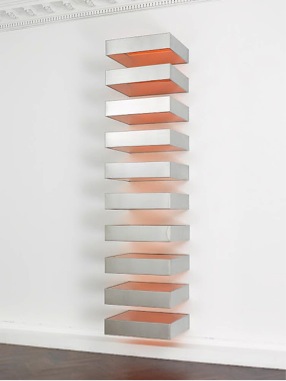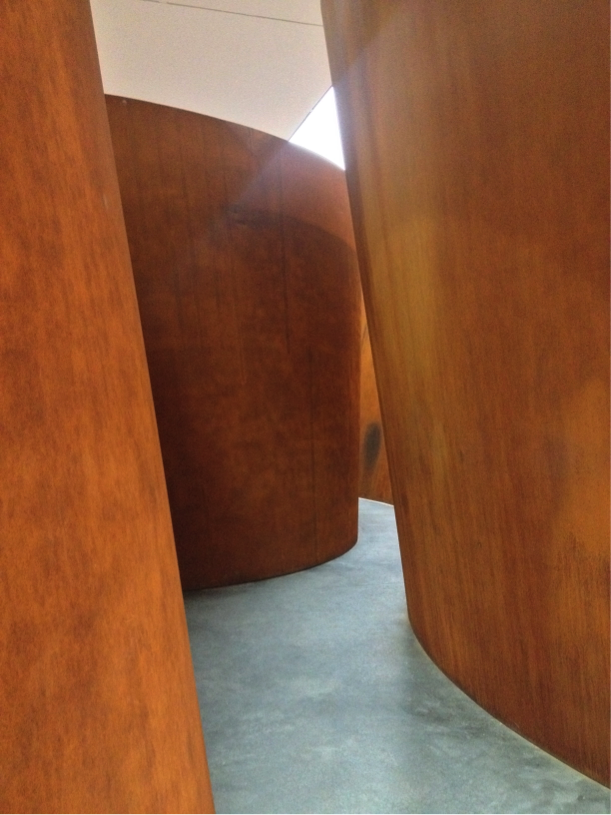
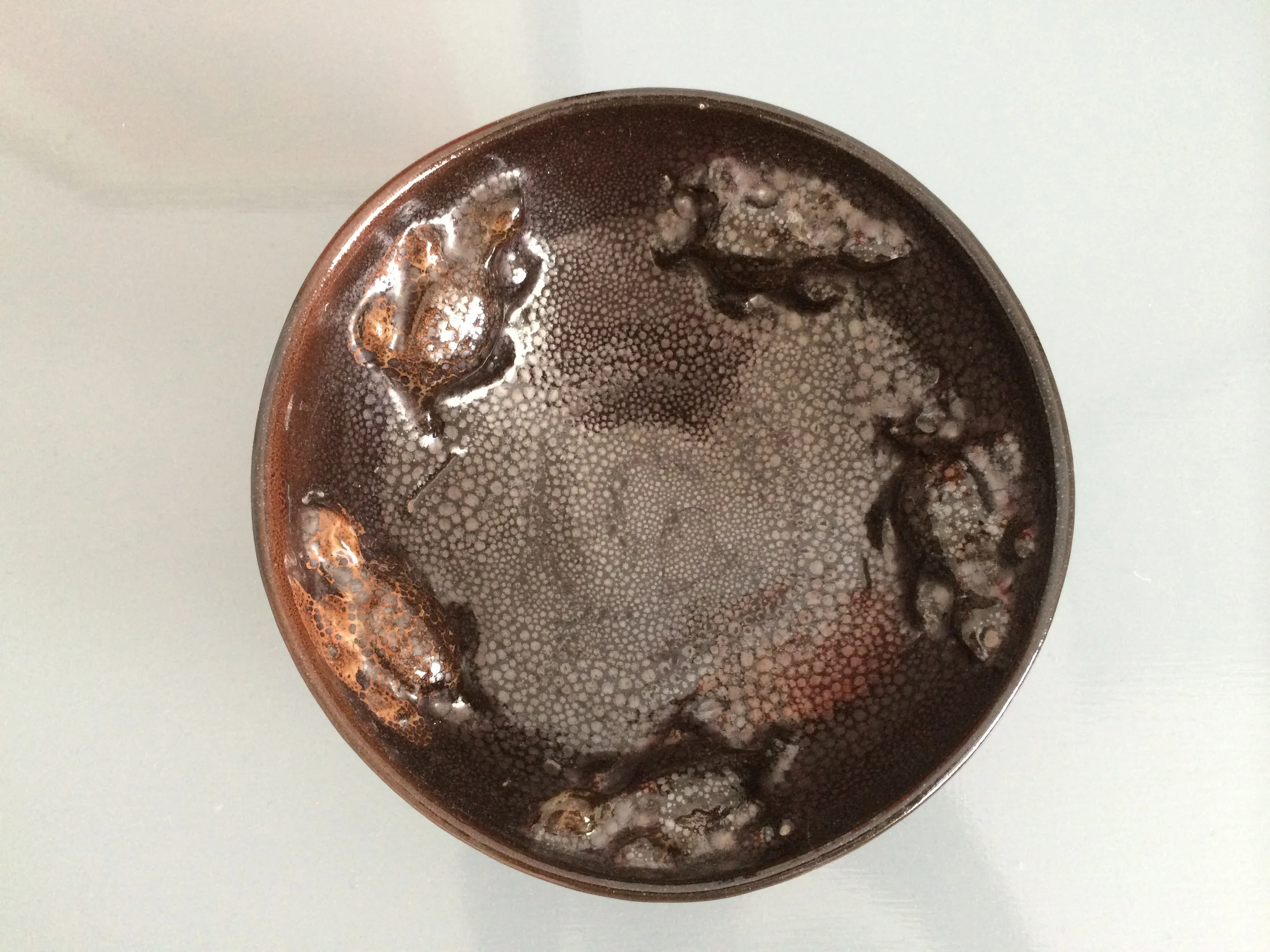

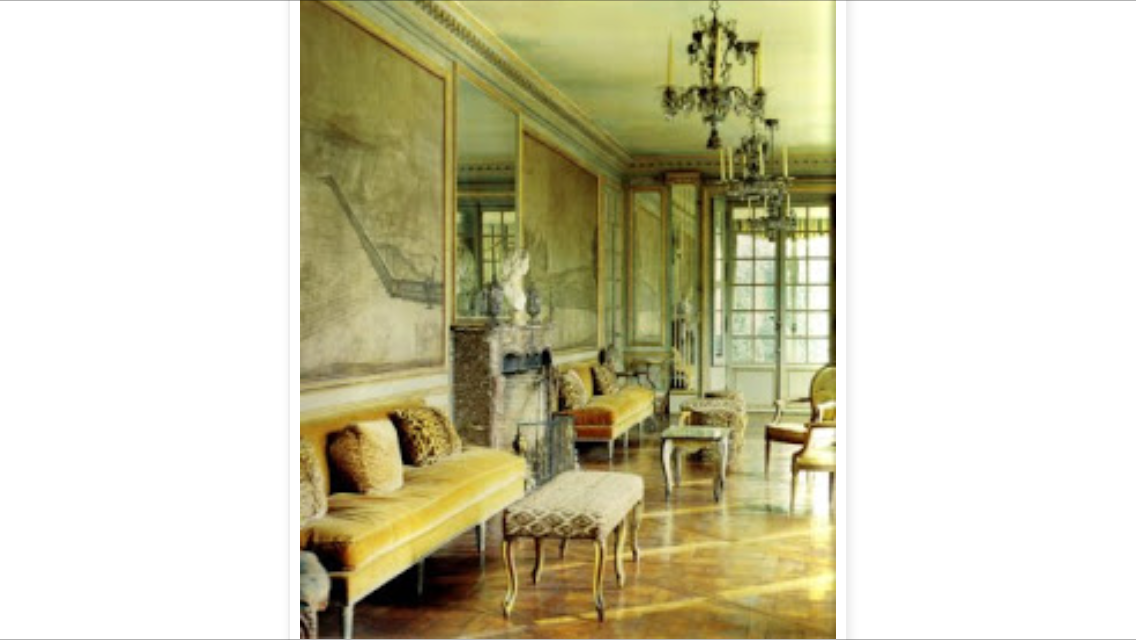

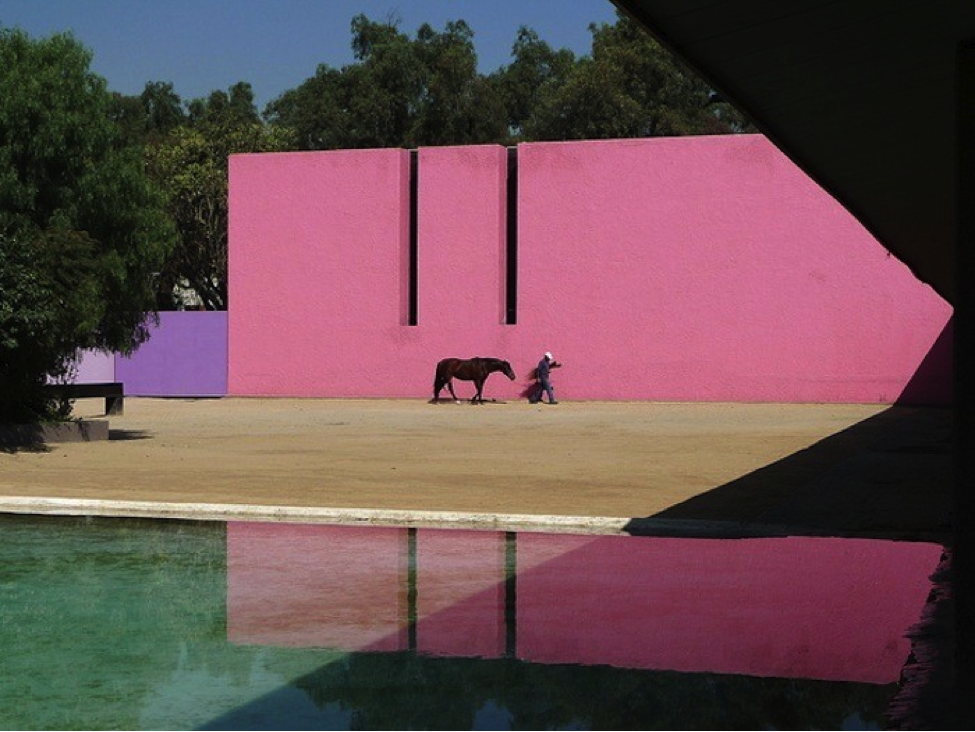

Seated Buddha Java, 9th Century
Lao-Tse, a great Chinese philosopher and poet from 6 century B.C.E. said:
"Thirty spokes meet in the hub,
but the empty space between them is the essence of
the wheel.
Pots are formed from clay,
but the empty space within it is the essence of the pot.
Walls with windows and doors form the house,
but the empty space within it is the essence of the
house."
~ Book of Tea by Okakura Kakuzo
Seated Buddha Java, 9th Century
Lao-Tse, a great Chinese philosopher and poet from 6 century B.C.E. said:
"Thirty spokes meet in the hub,
but the empty space between them is the essence of
the wheel.
Pots are formed from clay,
but the empty space within it is the essence of the pot.
Walls with windows and doors form the house,
but the empty space within it is the essence of the
house."
~ Book of Tea by Okakura Kakuzo
ma
Before I left the States to live in Japan in 1979, I had the opportunity to see a thrilling and unforgettable exhibit at the Cooper-Hewitt Museum in New York based on a not often talked about a Japanese concept called MA. The architect Arata Isozaki designed the exhibit.
He painstakingly built habitats to show the viewer Japan’s take on MA. It was exhilarating to see how he managed to make an ethereal concept so concrete. He even had rooms built within the museum. It sold me on wanting to visit the (is)land of MA.
What is MA? Listen closely as I whisper, ‘It’s a little known secret that keeps the universe moving within it’s gravitational orb.’
Here is a Japanese take on using natural air ventilation to cool in summer yet keep the heat contained during the cold, drafty winter months. This the Japanese way of cooling and heating before the advent of either air conditioning or central heating. This vestibule or long corridor between the outdoors and the interior rooms works as natural insulation.
Nanzenji Temple Kyoto, Japan Photo/John Hill

Chinese ceramic bowl with Turtles
"The Taoists were reacting to a strict Confucian world, of course, where everything was separated into neat categories. The Confucians would define a cup by what it looked like, the Taoists by nothing in the middle because without that it wouldn't be a cup. "
Victoria Finlay in her book, COLOR p. 91
Chinese ceramic bowl with Turtles
"The Taoists were reacting to a strict Confucian world, of course, where everything was separated into neat categories. The Confucians would define a cup by what it looked like, the Taoists by nothing in the middle because without that it wouldn't be a cup. "
Victoria Finlay in her book, COLOR p. 91
In the west we speak of MA as “negative space”. I don’t think this term is adequate although it is often used in art and sculpture. It is the space that exists in and around and even through objects. Did you know the most seemingly solid objects are porous? Metal included.
MA is the space that contains, supports and envelopes any object. Essentially it is MA that grants an object the right to exist.
MA is the air inside the vase that gives it its shape. It is also the air that surrounds the vase and supports its shape.
MA is present in the placement of these words on paper and each letter having their negative and positive space to form the letter. If not for this variation everything would be either solid white or solid black.
MA gives each letter its shape and each word its meaning. And then it connects the many words to make a sentence, a paragraph, a page, and after all a complete story.
Mandy Patinkin, a singer and actor on the TV show Homeland said a Palestinian musician he was playing with referred to the native tuning of his instrument as being “the sound between the black and white keys.”

Matisse's textile from India
When I visited the Matisse Museum in Nice, I had an epiphany; realizing that Matisse borrowed from the technique of open embroidery to make his cutouts. When I discussed this with my friend, a quilter, who has has spent her life between Nice and NY (not bad/pas mal) while walking through the MoMA show of Matisse’s cut outs she said, “that makes perfect sense!”.
Matisse's textile from India
When I visited the Matisse Museum in Nice, I had an epiphany; realizing that Matisse borrowed from the technique of open embroidery to make his cutouts. When I discussed this with my friend, a quilter, who has has spent her life between Nice and NY (not bad/pas mal) while walking through the MoMA show of Matisse’s cut outs she said, “that makes perfect sense!”.
Antibes
Antibes
Antibes
Antibes
The wind through these letters in an outdoor sculpture by Juame Plensa in Antibes create a sound.
http://petanqueandpastis.typepad.com/my_weblog/2007/08/la-grande-nomad.html
Yohaku is the Japanese term used to refer to the abundance of white space within visual composition. This white space is also referred to as the the ideological nothingness of Chan Buddhism in China and Zen Buddhism in Japan: the nothing that is everything, a powerful entity that both defies and embodies the definition of its nothing name. Painters within these sects of Buddhism used simple ink brushstrokes to emphasize the symbolic "nothing" or mu. As early as tenth century China, this blank space was considered spirit or ki.
MC Escher
MA is this unseen but ever present current. It supports both airplanes and birds so they remain airborne...
MC Escher
MA is this unseen but ever present current. It supports both airplanes and birds so they remain airborne...
Donald Judd so eloquently and concretely expresses this concept in his sculpture, Stacks
With Marre Moerel, we made stacking shelves in my kitchen. Was Donald Judd’s sculpture our subconscious inspiration?
is ma a dance, a rhythm, a breath?
You and I know MA because we live it and breathe it. In yoga, we learn it is that almost invisible pause between our intake and out-take of breath. Good writers, speakers and dancers work with it, using it as the pause between the action.
This rhythm is going on inside us all the time: it is our heartbeat and it is our breath. How could we live without it?
It’s how we make our place – metaphorically, our dance in life. It is also our connection to life. Some people may not know the concept MA because they are too busy living it.
We may not consciously have it or at times feel we have lost it. We can develop our connection to it simply by making ourselves aware of it – aware of our connection to the universe. It is that basic. It is forgiving if we again lose sight of it. It lets us back in whenever we are consciously ready to receive it.
When we are designing we are not just filling a space with objects to make it
replicate a pretty picture. Instead, we are creating a flow around and between each object. The space that exists around the piece is as important as the piece itself. For this reason, it is important choose well proportioned furniture to live with.
My dear departed teacher, Rudolph Schaeffer would say composition takes in 2 perceptions; the dynamic rhythmic movement of the parts and the other the static immobility of the whole. This gives us balance.
A fine composition "breathes" rhythmically thereby quieting the mind.
If an object or piece of furniture does not work in one area, then we should find that sweet spot that contains it better. If too big, then that area might have to be grander to give it more space.
If nowhere works, but you love the piece and don’t have room to store it, share it. Hold in your thought that by doing so – either by selling it or giving it away - you are granting someone who has the space for it a gift and an opportunity to enjoy it as you have done.

Elsie de Wolfe Interior
Do not admit an unnecessary rug, or chair, or picture, lest you lose the spaciousness, the dignity of the room. An overstuffed chair will fill a room more obviously than a grand piano. - if the piano is properly, and the chair improperly placed.
-Elsie de Wolfe
Elsie de Wolfe Interior
Do not admit an unnecessary rug, or chair, or picture, lest you lose the spaciousness, the dignity of the room. An overstuffed chair will fill a room more obviously than a grand piano. - if the piano is properly, and the chair improperly placed.
-Elsie de Wolfe
I was invited to a friend’s summer home in Sag Harbor to make her home ready for selling. The living room and side room were small, narrow spaces and clearly the furniture she bought for them was too big and overstuffed looking for the areas. She bought the pieces because she loved them and didn’t consider where they were going. No measurements were taken and no sketches were made.
We could effectively rearrange the living room pieces but when it came to the side room there were simply too many overstuffed chairs in a room not much bigger than some peoples walk in closet. She realized this but had a hard time letting them go.
Arranging furniture in a room is akin to sculpture - we are aware of the proportions of the room in relation to the objects we are placing in it.
A friend who is an interior designer and had been an assistant to Diana Vreeland calls my studio "The Zen Hotel", now just The Zen. When I asked her what made it Zen-like, both in it’s past and most recent incarnation, she said, “It’s because of the uncluttered space. Space which gives you room to breath and to think.”
Ron Powers said of Mark Twain
"He understood the strength of the pause between the words."
Paul Horn said of Miles Davis
"He was a master of space, the space around the notes."
Here it what Richard Serra, the sculptor, said about space as he walked us through he sculpture Belamy in an interview with Charlie Rose.
"…on these pieces it's very also difficult to know when you're on the inside and what's on the outside. Here we're on the inside of the outside but we're also on the outside of the inside. Space has become my subject and it's basically what informs how people think about what I'm doing. The steel is kind of a way of holding the space, or directing the space or compressing the space or allowing you to feel the grasp of the space. So the steel in the space or the object in the void become one and the same. So I don't think of space as being something apart from the condition of sculpture. It's one and the same. Basically that is my subject. I use steel to organize space."

Richard Serra talking about Japanese Raked Gardens
Richard Serra on Zen Gardens
…they're about walking and looking in time and space and they're not about an object. They're about a field. So if you go to Ryoanji and there's 7 rocks you don't look at the rock as a specific thing. You walk along a viewing portion, one rock is hidden behind the other rock or you watch the sun go up and down. But in most of those gardens you're walking in curvilinear paths and things appear and disappear. So it's not about the containment of one object, it's about the notion of time space and movement being simultaneous. The notion of an open field; of walking through, into, and around. Of things locating themselves in space that are barometers for seeing through and into the space, that became really paramount for me.
Richard Serra talking about Japanese Raked Gardens
Richard Serra on Zen Gardens
…they're about walking and looking in time and space and they're not about an object. They're about a field. So if you go to Ryoanji and there's 7 rocks you don't look at the rock as a specific thing. You walk along a viewing portion, one rock is hidden behind the other rock or you watch the sun go up and down. But in most of those gardens you're walking in curvilinear paths and things appear and disappear. So it's not about the containment of one object, it's about the notion of time space and movement being simultaneous. The notion of an open field; of walking through, into, and around. Of things locating themselves in space that are barometers for seeing through and into the space, that became really paramount for me.
This trip was so meaningful to Serra that he goes on to say,
"So when I came back to build a piece for Pulitzer I had to deal with 3 or 4 acres of land and find a way of dealing with the elevations rises and falls and holding a view, a meaningful view of that landscape as you walked it that would be comprehensible to a viewer. So things weren't just indiscriminately placed. That being my first landscape piece probably remains still remains one of my most abstract pieces ever done. Maybe one of my best efforts."

Luis Barragan house
In the gardens and homes designed by me I have always endeavored to allow for the interior placid murmur of silence, and in my fountains, silence sings.
~Barragan, when accepting his Pritzker Prize
Luis Barragan house
In the gardens and homes designed by me I have always endeavored to allow for the interior placid murmur of silence, and in my fountains, silence sings.
~Barragan, when accepting his Pritzker Prize
the moment contains calm
Here are some techniques I’ve found helpful and maybe you will too.
I like to take a few minutes a day to walk. Away from the clutter of images and messages that has become my life. Walk in nature, meditate, do yoga, make music, dance or do anything you love…dare I say sex? (Which can be a whole other subject.)
Recently I read in a prayer for the Sabbath (abstinence from work by religious Jews from Friday night at sundown until Saturday evening at sundown) at a beautiful neighborhood synagogue called Central Synagogue
“And make us sensitive, God
Sensitive to the sound of the words
Which others speak –
Sensitive to the sound of their words
And to the silences between.”
When stressed, I take a moment to listen to the ambient sound. To become aware of my breathing. Breathing in, breathing out and the pause between the breath. The moment contains calm.
Musicians and artists make it their business to be aware of this special concept. John Cage called it the space between the notes. He even had the audacity to make concerts out of this “silence”. No music. Giving the audience the opportunity to listen to and become aware of ambient sound. Can we imagine a cough, or a sneeze, or maybe the shuffling of papers from the program? The piece was called 4’ 33” because this “performance” would last for 4 minutes, 33 seconds.
Each of the 3 artists below worked in the mid 20 century and had an ability to reach into the space around their material to let their work breathe. Below right is a sculptural piece by Lippold which John Cage, the musician lived with in his loft.
Lippold artwork/John Cage MoMA exhibit
A consummate textile artist, Lenore Tawney(right), used the breath of open space to fill her pieces with awe and wonder.
Below is the work of the sculptor Barbara Hepworth. Her work has sustained years of notoriety because stayed true to her vision of intermingling form and space.
Lenore Tawney Cooper-Hewitt exhibit Making Design
repetition and rhythm
Copenhagen, Denmark
Another technique I have found useful when trying to find the right answer or even to put myself back to sleep, is to shut my mind off from its constant dialogue. I cease my inner chatter by going back to a time before I could use language. If I go back that far, which can be in the blink of an eye, I can’t hold onto a thought.
This rhythm is what makes spaces, places and people sing. It is the intervals, the beats and the syncopation. It is the repetition.
The intangible MA seems to be tied to rhythm. There is a rhythm in our heartbeat and a rhythm to our breathing. Not coming from a musical family my first sense of creating rhythm happened walking by an iron gate and moving my fingers along it’s repetitive spikes.
Another early memory of this repetition and rhythm was playing in my grandmother’s bedroom apartment, so close to the elevated train. Hearing at repeated intervals the “chu chu” of the train, sounding louder as it got closer and then receding into space.
What is your early memory?
This too is MA.
Oh, and thanks to you, Ma.
After offering you all these do’s to think about, I offer you one final thought,
“Don’t fuss over design, let it breathe.”




